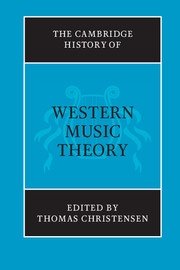Book contents
1 - Mapping the terrain
from PART I - DISCIPLINING MUSIC THEORY
Published online by Cambridge University Press: 28 March 2008
Summary
Every musical culture possesses its own representation of what constitutes its music theory, a “map” of the domains of inquiry or precept and the relations between these domains, thus providing a degree of completeness and coherence to the discipline. The works of some theorists contain explicit and comprehensive mappings: this is particularly the case in music theory of the sixteenth and early seventeenth centuries. Yet there also are implicit mappings of music theory, which are to some degree recoverable by the historian. Often, the appearance of new theoretical constructs is symptomatic of an underlying remapping of the realm of theory. Particularly after the middle of the seventeenth century explicit mappings of theory come to have a metatheoretical and disciplinary function, often seeming to be attempts to stabilize a discourse perceived as being on the verge of fragmentation. For the purposes of this exposition, we will distinguish three broad historical cartographies, the first governing music theory through the sixteenth century, the second governing seventeenth- and eighteenth-century theory, and the last governing theory after the turn of the nineteenth century.
Architectures and harmonizations
The most basic representation of music theory is the schema, an attempt to analyze or systematize a body of knowledge through its division into idealized categories. As such, it is akin to classification, with the distinction that the latter pertains to autonomous data (harmonies, pieces, styles, etc.). A simple phenomenal schema of music might hypothetically distinguish the attributes of pitch and temporality, and indeed, theoretical schemas often do involve such binary discriminations.
- Type
- Chapter
- Information
- The Cambridge History of Western Music Theory , pp. 25 - 45Publisher: Cambridge University PressPrint publication year: 2002
References
- 4
- Cited by



